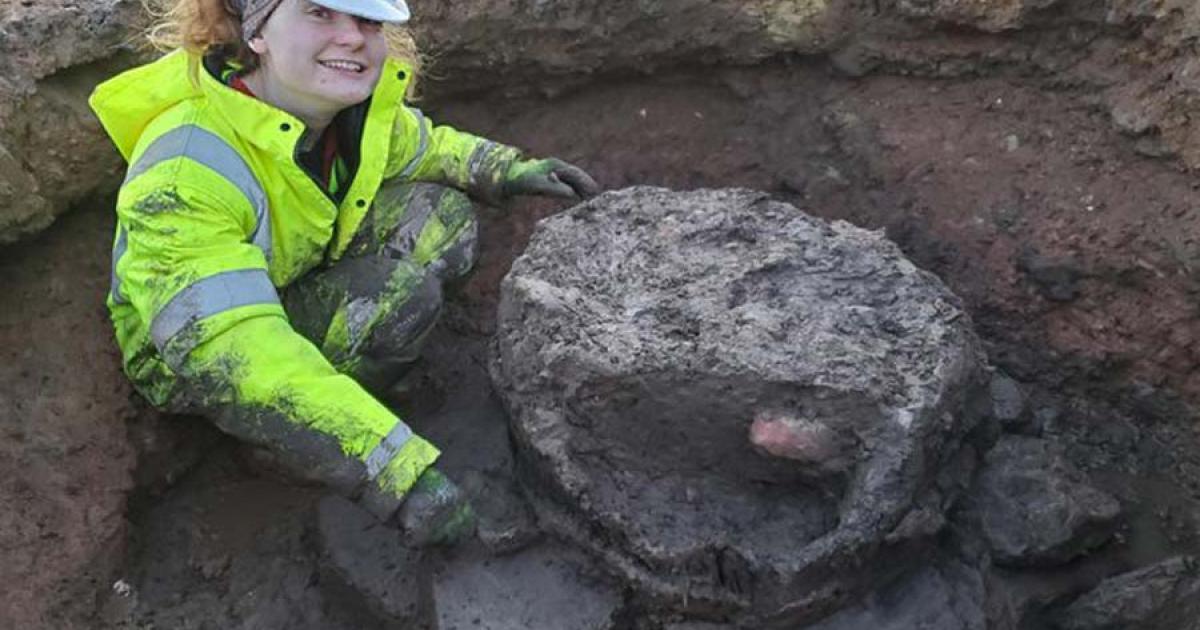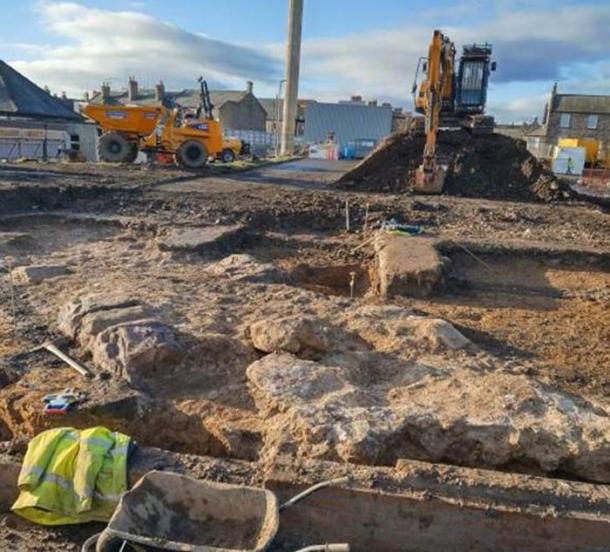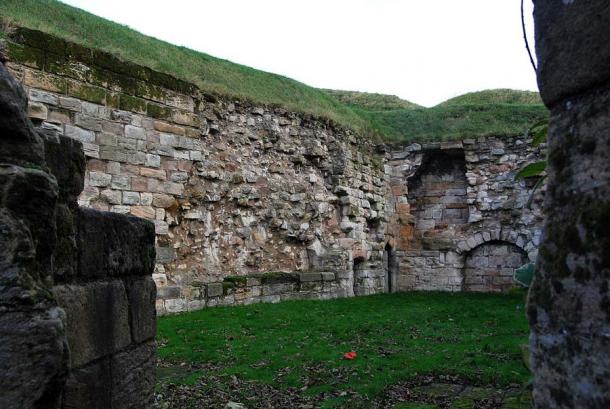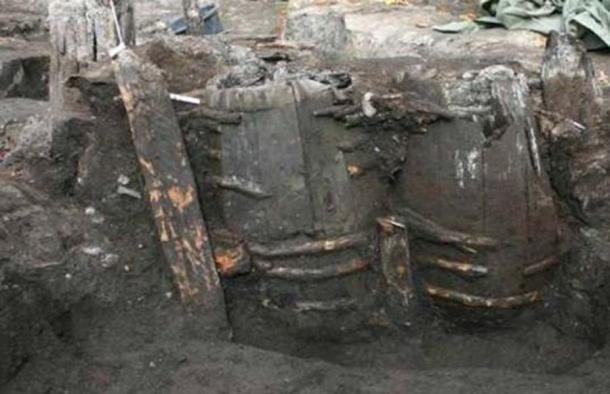
Medieval Loo and Strange Foundation Walls Found at UK’s Berwick Hospital
An archaeological dig prior to the demolition of the Old Berwick Hospital site, built in 1874 in the town of Berwick in Northumberland, continues to unveil interesting discoveries about the town’s medieval past. The latest finds, though, have thrown up some questions and caused quite a stench. These include questions about the strange remains of fortification walls facing in directions not understood, and a medieval barrel latrine completely full of human excrement and urine.
The Old Berwick Hospital is being replaced by a 36 million Euro (41 million dollars) state-of-the-art hospital, according to the website of the Northumbria Healthcare NHS Foundation Trust, which is building it. Construction work will begin in the spring, after the demolition is complete.

The Old Berwick Hospital demolition unveiled these odd fortification walls that seem to face in directions where there was nothing to defend. (Northumbria Healthcare NHS Foundation Trust)
The Old Berwick Hospital and Berwick’s Medieval Past
Berwick-upon-Tweed, the northernmost town in England, lies on the Anglo-Scottish border and was the setting for all kinds medieval raids, sieges and takeovers. This town changed hands more than once going from England to Scotland or the other way around.
Since 1482, however, it has been in England’s possession although its residents are a bit confused about questions of identity and loyalty. The town’s medieval walls and huge Elizabethan ramparts are among its well-known architectural features and are well documented in historical records, according to the Northumbria Healthcare NHS Foundation Trust website.
- Medieval Graffiti to Repel Witches and Evil Spirits Found In Britain
- In Medieval Britain, If You Wanted to Get Ahead, You Had to Speak French
The Old Berwick Hospital site archaeological dig, carried out by Northern Archaeological Associates, a subsidiary of Ecus Archaeology, has been ongoing since April 2021. Since the digs began a steady trickle of fascinating discoveries have been uncovered that have told historians much more about the town’s medieval life. Archaeologists have found a number of shoes, shards of pottery, ancient walls and fishbones believed to date back 900 years were some of the finds at the site, the BBC reported . Two wells, one dating to the late 15th or 16th century and another to the 1820s were also found. Interestingly, one of them contained the near-complete remains of a donkey or pony.

A detail of the known Berwick-upon-Tweed fortress walls, which historians do understand unlike the strange fortification walls found at the Berwick Hospital site. (Russ Hamer / CC BY-SA 3.0)
Fortification Walls Defending What?
However, what has archaeologists in quite a puzzle is the new evidence about the town’s medieval fortifications that has most recently been found. This is the “completely unexpected” discovery of the foundations of a 4-metre (13 feet)-wide defensive wall alongside a 12-metre (39 feet)-wide by 2-metre (6.5 feet)-deep ditch, the Northumberland Gazette reports.
Site supervisor Craig Parkinson is quoted by ITV as saying, “They seem similar in construction to the earlier town defences, but face the wrong direction to be obviously associated with them. The alignment makes more sense as part of an outer wall of the castle, but they are much further away than would be expected if that were the case. Are they part of either of these, do they relate somehow to the later fortifications, or do they represent a phase of Berwick’s development that we were previously unaware of?”

The Old Berwick Hospital site also produced the remains of a barrel toilet. This is what that toilet might have looked like. These barrel toilets were unearthed in Denmark and date from the 14th century. (Odense City Museum)
A “Goldmine” of Human Remains
Along with the fortifications, has been discovered what constitutes a virtual “goldmine” for archaeologists, though the general public may consider that description for the remains of a medieval toilet and its smelly contents a bit questionable!
The barrel latrine was made of wooden planks bound together with twisted hazel. It was probably used to store foodstuffs before being put to use as a toilet. The waterlogged conditions at the site have ensured that the barrel and its contents have remained well-preserved. It was carefully excavated and wrapped in cling film before being sent to the York Archaeological Trust, where it is hoped the wood can be preserved and the barrel restored. As for the contents, they will, according to site supervisor Holly Drinkwater, be subjected to environmental analysis for the presence of seeds, grains, and intestinal parasites.
- Medieval Cancer Rates Were Shockingly High, New Study Shows
- Archaeology Graduate Discovered Lost City of Trellech After Using Life Savings to Buy Field
She is quoted on the Trust’s website as saying, “These environmental remains are a goldmine for archaeologists for reconstructing past diets and will be able to tell us a great deal about the eating habits and hygiene of the residents of medieval Berwick.”
The excavations at the medieval Berwick Hospital have been most productive and have added a lot of information about the town’s past. The small portion of a defensive wall that has lately been discovered, however, has archaeologists and historians intrigued. According to Parkinson, as quoted on the Trust’s website, “Only a short section of wall has been uncovered so far, and unfortunately much of it seems to have been removed during earlier hospital development in the 1970s, a time when less concern was given to the preservation and recording of historic remains.”
It is to be hoped that his skepticism notwithstanding, continuing excavations will unearth some more sections of the wall in a better state of preservation that will better help archaeologists understand its purpose.
Top image: The compacted human excrement found inside a medieval barrel toilet at the Old Berwick Hospital site in Northumberland, England. Source: Northumbria Healthcare NHS Foundation Trust
By Sahir Pandey
References
BBC. 2021. Berwick Infirmary excavation unearths medieval well. Available at: https://www.bbc.com/news/uk-england-tyne-59178326
Coulson, A. 2022. Eye-catching discoveries at Berwick hospital site dig. Available at: https://www.northumberlandgazette.co.uk/news/people/eye-catching-discoveries-at-berwick-hospital-site-dig-3580363
ITV. 2022. Medieval toilet and defensive wall foundations discovered in archaeological dig at Berwick Infirmary. Available at: https://www.itv.com/news/tyne-tees/2022-02-22/medieval-loo-discovered-in-archaeological-dig-at-berwick-infirmary
Northumbria Healthcare NHS Foundation Trust. 2022. Berwick barrel causes a stink while wall raises questions about town’s past. Available at: https://www.northumbria.nhs.uk/berwick-barrel-causes-a-stink-while-wall-raises-questions-about-towns-past/















